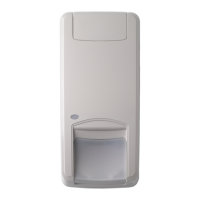4 / 42 P/N 146550999-1-ML • REV Q • ISS 07APR21
Installation guidelines
See Figure 1.
The detector is intended to be mounted on walls but can also
be mounted on ceilings by using a mounting bracket.
Use the following guidelines to determine the best location to
install the detector.
• Mount the detector so the expected movement of an
intruder is across the detection pattern (see Figure 3).
• Mount the DD1012(-D) detector at a stable surface at a
height between 1.8 and 2.6 m (5.9 and 8.5 ft.) from the
floor. Mount the DD1012PI detector at a stable surface
between 2.3 and 2.6 m (6.6 and 8.5 ft.) from the floor. See
“Specifications” on page 6 for details.
• Do not mount the detector within 0.5 m (1 ft. 8 in.) of
metallic objects or within 1.5 m (4 ft. 11 in.) of fluorescent
lights.
• Do not place objects in front of the detector that may
prevent a clear line of sight.
• Place detectors at least 6 m (19 ft. 8 in.) apart, and use
the short-range setting to avoid interference, when
mounting detectors face to face.
The dual technology processing of this detector is very
resistant to false alarm hazards. However, avoid potential
causes of instability, such as:
PIR hazards:
• Direct sunlight on the detector
• Heat sources within the detector field of view
• Strong air draughts onto the detector
• Animals in the field of view (DD1012(-D) detectors)
• Obscuring the detector field of view with large objects,
such as furniture
Microwave hazards:
• Mounting surface susceptible to vibrations
• Metal surfaces reflecting microwave energy
• Water movement through plastic pipes
• Moving or vibrating objects like fans, heating or air-
conditioning ducts
WARNING! The equipment is not earthed. Any
external circuit connected to the equipment must be
located within the same building and connected to a
protective earthing conductor.
Wire insulation of cables connected to the equipment must
conform to IEC 60332-1-2 and IEC 60332-1-3 or IEC 60332-
2-2, depending on the wire cross sectional area, or IEC TS
60695-11-21, regardless of cross sectional area. Alternatively,
such wires must comply with UL 2556 VW-1.
The detector power supply source must be power limited at
15 W.
We recommend that the detector is regularly walk tested and
checked at the control panel.
To install the detector:
1. Lift off the custom insert (see Figure 2, items 1 and 2).
2. Using a screwdriver, carefully prise open the detector (see
Figure 2, items 3 and 4).
Caution: Do not touch the pyroelectric sensor (Figure 6).
3. Take out the cover screw (Figure 4, item 2).
4. Fix the DD1012(-D) base to the wall between 1.8 and 2.6
m (5.9 and 8.5 ft.) from the floor. Fix the DD1012PI base
to the wall between 2.3 and 2.6 m (6.6 and 8.5 ft.) from the
floor. See “Specifications” on page 6 for details.
See Figure 4.
- For flat mounting, use a minimum of two screws
(DIN 7998) in positions A.
- For corner mounting, use screws in position B or C.
- To install the pry-off tamper ST400, use mounting
positions A. ST400 mounting position is shown as item 3
in Figure 4. Open the outlet in the back plate (Figure 5,
item 2).
5. Wire the detector (see Figures 4 and 13). Use back plate
cable inlets (Figure 5, item 1) and cable gutter (Figure 5,
item 3).
6. Select the desired jumper and DIP switch settings (see
“Setting the detector” on page 5 for more information.
7. Remove the blinders and add the stickers, if required. See
“Configuring the coverage pattern” on page 6 for more
details.
8. For ceiling-mount applications, use the SB01 swivel-mount
bracket. SB01 mounting position is shown as item 1 in
Figure 4.
9. Close the cover, insert the cover screw, and place the
custom insert.
Connections
See Figure 13.
Table 1: Detector Connections
Power supply connection (9 to 15 V,
12 V nominal)
Alarm relay output (33 Ω). Use jumper JA to
set the onboard EOL resistor in series with
the relay. See “Jumpers” on page 5.
Tamper switch output (0 Ω). Use jumper JT
to set the onboard EOL resistor in series
with the switch. See “Jumpers” on page 5.
This input enables and disables the LED
(walk test On/Off). Walk test mode can only
be entered when detector is in Day mode
(pin 8). Active high or low is determined by
SW1-3 (see “SW1-3: Polarity” on page 5).
This input switches the detector in day
(show memory on the LED indicator) or
night mode (activates the alarm memory and
clears previous stored alarms). Active high
or low polarity is determined by SW1-3 (see
“SW1-3: Polarity” on page 5).
Notes
• Inputs 7 and 8 are only useable when SW1-5 is set to
Remote on. See “SW1-5: Remote functionality” on page 5.
• The LED is only enabled when SW1-6 is set to LED on.
Figure 11 explains how to create a single zone with multiple
resistor configuration.

